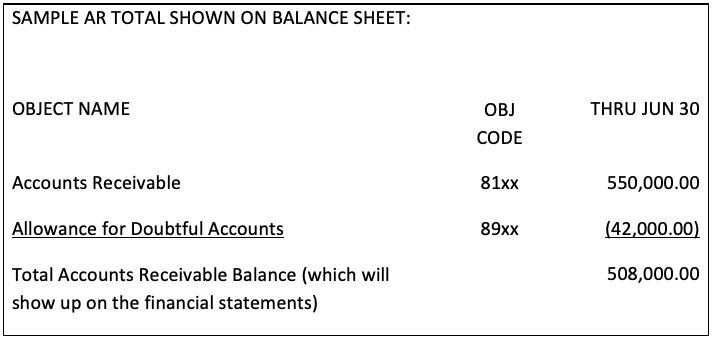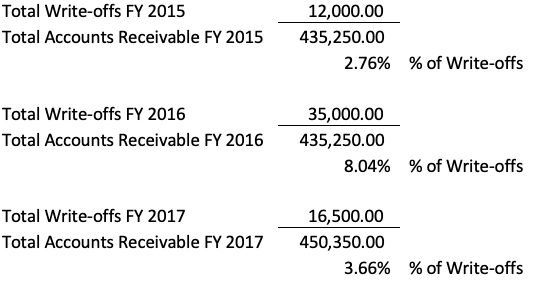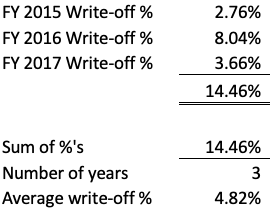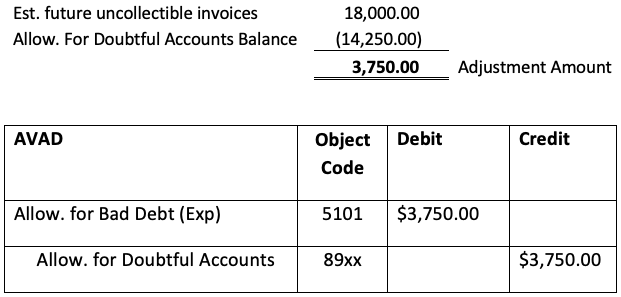|
SOURCE: |
Non-Student Accounts Receivable, Financial Management Services |
|
DATE ISSUED: |
December 2004 |
|
DATE OF LAST REVISION: |
March 2019 |
|
ARSOP NO: |
2.0 |
|
RATIONALE: |
To account for uncollectible receivables in accordance with Generally Accepted Accounting Principles (GAAP). All departments/units with an average Accounts Receivable balance of $500,000 or greater should establish and use a method of bad debt recognition that includes establishing an Allowance for Doubtful Accounts. |
|
ARSOP: |
All departments are required to calculate an Allowance for Doubtful Accounts to be submitted to Auxiliary Accounting each fiscal year with their Balance Sheet Backup. Only those departments with an average accounts receivable greater than $500,000 are required to record an entry for their Allowance for Doubtful Accounts. An Allowance for Doubtful Accounts is a contra asset account (meaning it either has a credit or zero balance) on the balance sheet that reduces the total receivables reported as collectible. Departments with average non student accounts receivable greater than $500,000, not including the allowance, must compute and record an Allowance for Doubtful Accounts on their balance sheet. The accounts receivable balance should be re-evaluated on an annual basis to determine whether or not an entry must be recorded. Often, it is not known which specific accounts receivable invoices will be uncollectible. An allowance is therefore established to estimate the value of those receivables believed to be uncollectible. This entry should be recorded so the income statement and balance sheet are fairly stated at the amount expected to be collected in receivables, thus satisfying the matching principle 1 . When netted against the gross total of accounts receivable, the true value of the receivables is reported. 
Computing and recording an allowance: A three-year write-off percentage average should be computed to determine the amount recorded for the Allowance for Doubtful Accounts. Calculating the allowance based solely on the prior fiscal year write-off percentage does not adequately predict future write-offs if the prior year write-off percentage is atypical. A three year average balances an atypical year with normal write-off percentages, which better represents write-off trends. Once the three year average percentage has been calculated, the percentage is then multiplied by the current year’s Accounts Receivables balance to establish the new fiscal year’s allowance amount. Organizations that do not have three years of data should make their allowance equal to their receivables balance greater than 120 days, unless otherwise approved by Financial Management Services. Step A: Divide the prior three fiscal years write-off amounts by the same years’ accounts receivable balances. Example: 
Note: The percentage of write-offs for FY 2016 is unusually high compared to FY 2015 and FY 2017. FY 2017’s allowance amount would have been much higher if it was based on the prior year’s atypical write-off percentage. Step B: Add all three years’ write-off percentages and divide the sum by three. Example: 
Step C: Multiply the average percentage calculated in Step B by the current year’s outstanding receivables balance to get the allowance amount for the new fiscal year. Example: 
Integrating the example, the correct AVAD entry is as follows: 
Adjusting the allowance: The allowance for doubtful accounts must be reviewed for possible material adjustments on an annual basis at minimum . An adjustment is not necessary if there is no material change in the estimated allowance value. It is recommended that the allowance be at least equal to the balance of outstanding invoices over 120 days old. Upon review of your Allowance for Doubtful Accounts the balance may be significantly higher or lower than the actual amount of uncollectible invoices. In this case, adjustments must be made to the allowance account so a fair representation of uncollectible receivables is shown. Adjustments can be made manually to increase the allowance if there are specific situations that individuals are aware that may cause collection issues. Example: 
If $21,710.19 was the balance of Allowance for Doubtful Accounts at June 30th, and only $14,250.00 of Accounts Receivable is estimated to be uncollectible in the future, the allowance unfairly represents your future estimated uncollectible accounts. In this case, a decrease to the Allowance for Doubtful Accounts balance and Allowance for Bad Debt (Exp) is necessary. 
If at September 30th, the estimated balance of uncollectible invoices increases to $18,000.00, an increase to the Allowance for Doubtful Accounts balance and Allowance for Bad Debt Expense is necessary. 
Exceptions to this standard operating procedure require the approval of the Controller, Chief Accountant or Director of Non-Student Accounts Receivable |
|
DEFINITIONS: |
Average Accounts Receivable should represent the sum of the prior fiscal year's twelve months accounts receivable balances divided by twelve. Materiality should be set at a level at which a user of the financial statements would not be influenced if this information were missing. Materiality should be agreed upon with campus administration for each unit individually. Non-Student Accounts Receivable are charges billed outside of the bursar system to students, as well as charges billed to external parties by the university for goods or services. Productive Activity is having a recent (within 30 days) promise to pay, in writing and signed by the debtor, or a current payment plan in place on the account. Additionally, Non-Student AR requires that all nonstudent payment plans have payment activity within 90 days of the plan effective date of the payment plan, or within 90 days of the invoice aging to 365 days old, unless otherwise stated in the terms and conditions of payment plan. |
|
CROSS REFERENCE: |
|
|
RESPONSIBLE ORGANIZATIONS: |
All Reporting Auxiliary and Service Centers |
1
"The matching principal means that revenues generated and expenses incurred in generating those revenues should be reported in the same income statement. Revenues for an accounting period are recognized in accordance with the realization principle. Then the expenses incurred in generating those revenues are determined in accordance with the matching principle. Thus, expenses are reported in the income statement for the accounting period in which the related revenues are recognized." (Intermediate Accounting, by Chasteen, Flaherty, and O'Conner; 1992; McGraw-Hill, Inc.; p.60).